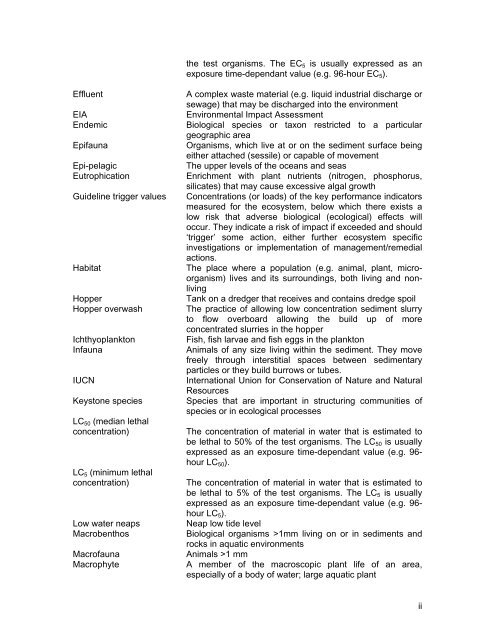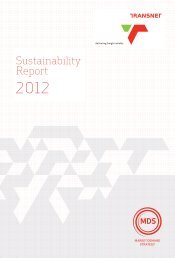BEN SCHOEMAN DOCK BERTH DEEPENING Specialist ... - Transnet
BEN SCHOEMAN DOCK BERTH DEEPENING Specialist ... - Transnet
BEN SCHOEMAN DOCK BERTH DEEPENING Specialist ... - Transnet
Create successful ePaper yourself
Turn your PDF publications into a flip-book with our unique Google optimized e-Paper software.
the test organisms. The EC 5 is usually expressed as an<br />
exposure time-dependant value (e.g. 96-hour EC 5 ).<br />
Effluent<br />
EIA<br />
Endemic<br />
Epifauna<br />
Epi-pelagic<br />
Eutrophication<br />
Guideline trigger values<br />
Habitat<br />
Hopper<br />
Hopper overwash<br />
Ichthyoplankton<br />
Infauna<br />
IUCN<br />
Keystone species<br />
LC 50 (median lethal<br />
concentration)<br />
LC 5 (minimum lethal<br />
concentration)<br />
Low water neaps<br />
Macrobenthos<br />
Macrofauna<br />
Macrophyte<br />
A complex waste material (e.g. liquid industrial discharge or<br />
sewage) that may be discharged into the environment<br />
Environmental Impact Assessment<br />
Biological species or taxon restricted to a particular<br />
geographic area<br />
Organisms, which live at or on the sediment surface being<br />
either attached (sessile) or capable of movement<br />
The upper levels of the oceans and seas<br />
Enrichment with plant nutrients (nitrogen, phosphorus,<br />
silicates) that may cause excessive algal growth<br />
Concentrations (or loads) of the key performance indicators<br />
measured for the ecosystem, below which there exists a<br />
low risk that adverse biological (ecological) effects will<br />
occur. They indicate a risk of impact if exceeded and should<br />
‘trigger’ some action, either further ecosystem specific<br />
investigations or implementation of management/remedial<br />
actions.<br />
The place where a population (e.g. animal, plant, microorganism)<br />
lives and its surroundings, both living and nonliving<br />
Tank on a dredger that receives and contains dredge spoil<br />
The practice of allowing low concentration sediment slurry<br />
to flow overboard allowing the build up of more<br />
concentrated slurries in the hopper<br />
Fish, fish larvae and fish eggs in the plankton<br />
Animals of any size living within the sediment. They move<br />
freely through interstitial spaces between sedimentary<br />
particles or they build burrows or tubes.<br />
International Union for Conservation of Nature and Natural<br />
Resources<br />
Species that are important in structuring communities of<br />
species or in ecological processes<br />
The concentration of material in water that is estimated to<br />
be lethal to 50% of the test organisms. The LC 50 is usually<br />
expressed as an exposure time-dependant value (e.g. 96-<br />
hour LC 50 ).<br />
The concentration of material in water that is estimated to<br />
be lethal to 5% of the test organisms. The LC 5 is usually<br />
expressed as an exposure time-dependant value (e.g. 96-<br />
hour LC 5 ).<br />
Neap low tide level<br />
Biological organisms >1mm living on or in sediments and<br />
rocks in aquatic environments<br />
Animals >1 mm<br />
A member of the macroscopic plant life of an area,<br />
especially of a body of water; large aquatic plant<br />
ii

















